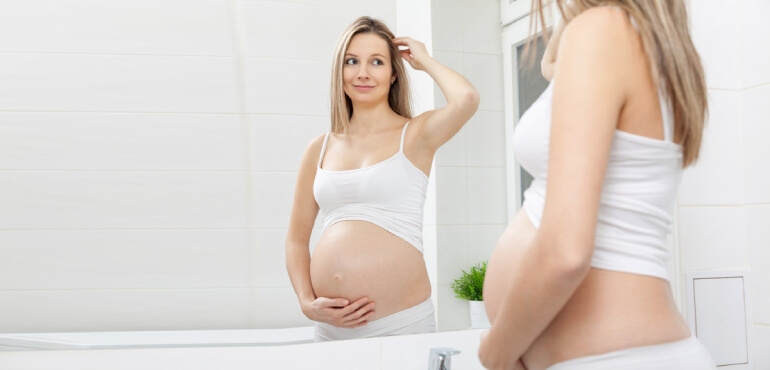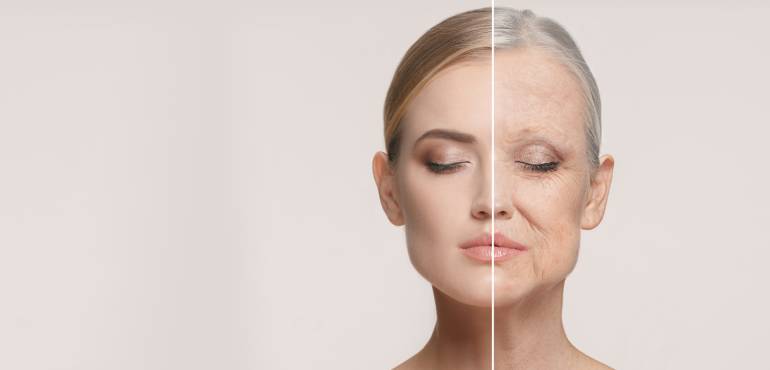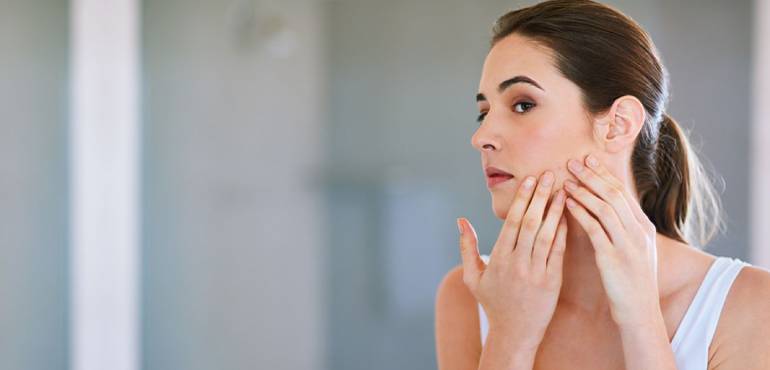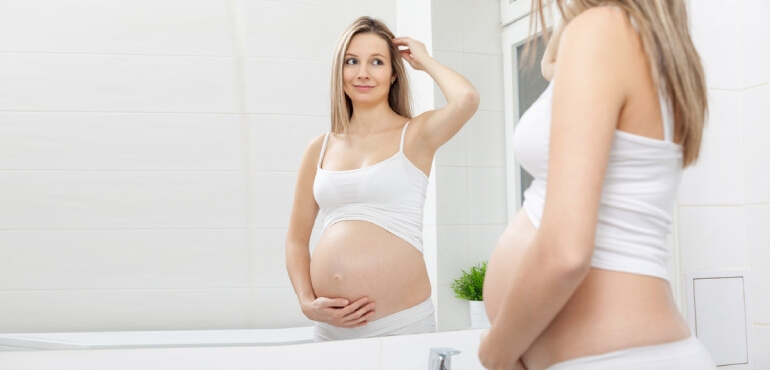SKIN AND HAIR IN PREGNANCY

The physiologic changes that occur during pregnancy are the results of hormonal and metabolic adaptations that are necessary to support the developing fetus. They also produce a variety of cutaneous findings, which are easily apparent to both patient and physician.
COMMON CHANGES
1. Pigmentary disturbances are the most common of these physiologic changes. (90%)
- Hyperpigmentation occurs in areas that are already pigmented, particularly the nipples, areolae, and genital areas.
- The midline of the abdominal wall (linea alba) becomes darker (linea nigra). Occasionally hyperpigmentation may affect the axillae and upper medial aspect of the thighs. This pigmentation usually fades after delivery, but seldom to its previous level.
- Birthmarks, moles, and freckles may also darken.
MELASMA(The Mask of Pregnancy)
- In approximately 70% of women, especially those of dark complexion, melasma (or chloasma) pigmentation also develops during the second half of pregnancy.
- It is characterized by irregular, sharply marginated areas of hyperpigmentation distributed in a symmetrical pattern either on the central part of the face or on the forehead and temples, or both.
- Melasma usually fades completely after parturition, but in Indian women, it persists and requires treatment post? delivery.
- The disorder is known to be aggravated by ingestion of contraceptive pills and exposure to sunlight.
2. Hair growth increases in pregnancy, and your hair may be greasier.
After the baby is born, it's going to seem as if you're losing tons of hair but you are simply losing the extra hair. This is called telogen effluvium.Telogen effluvium occurs one to five months after delivery and varies in its severity.
- Hair regrowth in a year is the usual course.
3. The nails often become brittle during pregnancy.
4. Glandular changes
- Sebum secretion increases during pregnancy and returns to normal after delivery.
- The level of sebum remains raised during lactation.
Pregnancy acne
- Unfortunately for some, the influx of hormones can cause the skin to produce more oil, which can lead to clogged pores and acne breakouts.
5. Vascular changes
- Vascular ‘spiders’ are very common in white women but are less in black women.
- They usually disappear post-delivery.
- Palmar erythema(redness on the palms) is also common, affecting at least 70% of white women and 30% of black women.
Palmar erythema and vascular spiders commonly occur together and are probably brought about by the general increase in vascularity associated with high estrogen levels.
- Small hemangiomas (bright red nodules of extra blood vessels) appear on the head and neck in about 5% of pregnant women.
- Varicose veins of the legs and hemorrhoids are frequent complications of pregnancy.
- Many pregnant women also develop non-pitting edema (swelling) of the face, eyelids, and disappear during the course of the day.
6. Stretch marks (striae gravidarum)
- Many women develop stretch marks during their pregnancy, usually within the last 3 months.
- They usually appear on your stomach or sometimes on your upper thighs or breasts. Stretch marks aren't harmful and over time, your skin will shrink and therefore the stretch marks will fade into white-colored scars.
7. Itching
- A small number of girls develop an itchy rash during their 3rd trimester, most frequently after 34 weeks.
- You may have itchy red bumps, often in large patches.
The rash will often get on your belly, but it can spread to your thighs, buttocks, and arms.
8. Skin tags
Extra bits of skin hanging off your body may be suddenly seen, which are harmless. Pregnancy hormones also can increase somatic cell production and cause small polyps to make anywhere your skin rubs against your clothing.
REASON FOR SKIN AND HAIR CHANGES
Acne- During pregnancy, the sebaceous secretion tends to increase during the last trimester of pregnancy, a period in which the estrogens, which suppress the sebaceous activity, are increased. It is believed that the stimulating factor comes from the pituitary gland (hypophysis). During lactation, the secretion stimulates prolactin secretion, which can directly stimulate the sebaceous glands or increase their response to androgens.
Pigmentation- During pregnancy, there are marked changes in the levels of sex hormones, particularly estrogen and progesterone, and this can lead to profound pigmentary changes in the skin.
Increased hair growth- It occurs because during pregnancy there is an improvement in the number of anagen hairs (growing phase) and a decrease in the elimination of hair, which continue its development until childbirth.
After delivery, there is a telogen effluvium which will increase the loss of terminal hairs from one to five months after childbirth, lasting up to one year. The decline is reversible.
Varicose veins- Pregnancy, as an acquired etiological factor, contributes to the early development of the varicose process, due to compression of pelvic and abdominal venous vessels, hormonal increase, and circulating maternal-fetal fluids. Its origin seems to be related to high estrogen levels during pregnancy.
PRECAUTIONS
These changes typically resolve postpartum. Thus, it may be appropriate to postpone non-urgent and cosmetic interventions until after delivery. Educating patients on the physiologic nature of these changes in the skin and related structures can often alleviate the distress that patients may experience.
1. For pigmentation- Prudent measures to avoid sun exposure include hats and other forms of shade combined with the application of a broad-spectrum sunscreen at least daily.
Sunscreens containing physical blockers, like titanium oxide and flowers of zinc, are preferred over chemical blockers due to their broader protection.
2. For stretch marks- Avoiding excessive weight gain during pregnancy can minimize your risk of getting stretch marks.
Many lotions and oils claim to scale back stretch marks. These products may smell and feel good, but they can't really prevent stretch marks from forming.
3. For acne- it is necessary to act in several causal factors. It is essential to consider hygiene of the skin, but not excessively, in order not to irritate the skin: to adjust the pH of the soap, avoiding the more alkaline, selecting less comedogenic topical products, and applying drugs only when prescribed by specialist doctors. During pregnancy, there is a strict contraindication of more effective drugs such as tretinoin and isotretinoin in pregnancy.
TREATMENTS
1. Chloasma can be difficult to treat. Destructive modalities (eg, cryotherapy, medium-depth chemical peels, lasers) yield unpredictable results and are related to a variety of potential adverse effects.
The mainstay of treatment remains topical depigmenting agents.
2. Stretch marks- Many lotions and oils claim to reduce stretch marks. These products may smell and feel good, but they can't really prevent stretch marks from forming.
3. Acne- Clean your skin twice a day and use products that are oil-free, non-comedogenic (doesn’t block pores) and non-acnegenic
4. Hirsutism- There are several options to treat hirsutism: shaving, waxing, electrolysis, and laser hair removal. The treatment using laser has become very popular and effective in recent years.
5. Varicose veins- Resting, leg elevation, and elastic stockings are recommended. They can be treated by specialists, with aesthetic purpose, by means of electrocoagulation and laser therapy
DIET PLAN FOR GOOD SKIN AND HAIR IN PREGNANCY
1. Omega-3 fatty acids -Sardines are widely considered the safest and most sustainable fish to eat, while seaweed is a rich vegetarian source of Omega-3s.
2. Cut down on caffeine, which can interfere with iron absorption.
3. Eat smaller, more frequent meals rather than a few large ones.
4. Be cautious about foods that may be harmful to pregnant women. These include soft cheeses, sushi, raw sprouts, and fish such as albacore tuna, swordfish, tilefish, and king mackerel that contain high levels of mercury.
5. High-quality protein. Opt for high-quality protein from fish, poultry, dairy, and plant-based protein sources rather than relying on just red meat.




